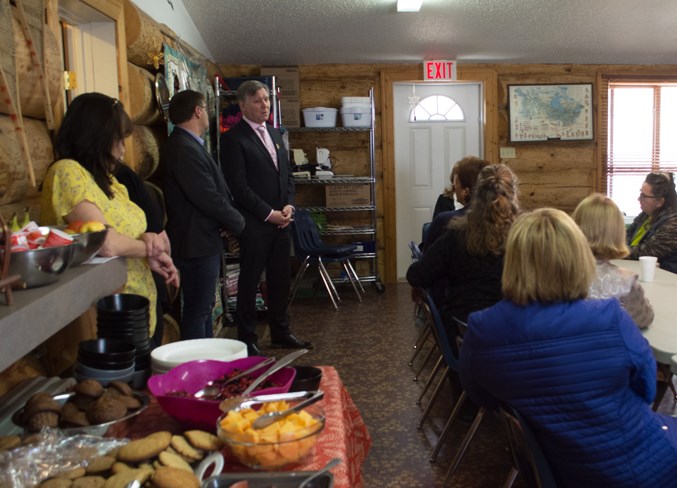With a taste fried bannock and invitations for future visits, Alberta’s Indigenous Relations Minister Richard Feehan enjoyed a warm welcome April 26 at the Athabasca Native Friendship Centre.
About 30 Athabascans and community representatives were at Feehan’s stop in town, which took place during the constituency break last week as ministers stopped in communities across the province.
The minister’s talking points ranged from intergenerational trauma and water access on reserves to bitumen pipelines and natural resources. Guests included Town of Athabasca Councillors Ida Edwards and Rob Balay, Athabasca University president Neil Fassina and other community group representatives.
“Our commitment has been to if the issue for the basis of that trauma a lot is the structural oppression, then we have to deal with it with structural change,” Feehan said while speaking to the group.
In an interview after his talk, Feehan said the provincial government is looking not only at how First Nations benefit not only monetarily from resources, but how do they have equity participation.
“So they’re actually part owners,” he said. “How do we make sure that they have a seat at the table where they’re actually making the decisions that are important? And we’ve don’t that in many different areas.”
He pointed to an example of the electricity market – how a company cannot bid into the second round of a renewable energy program unless there is at least a 25 per cent in First Nations equity participation.
“Now that’s a statement,” he said. “The statement is, not only do we want people to be able to have jobs, but we want to let them be in the place where they’re deciding what the company does and they’re making choices. Because we know that they – once they get to the table – will bring both the economic knowledge and the environmental knowledge and combine them in a really significant way.”
Feehan also praised Athabasca’s friendship centre facility. He noted that he has visited 46 out of Alberta’s 48 First Nations as well as its eight Métis settlements, in addition to other communities.
“(The centre) it’s beautiful, isn’t it?” he said. “It’s an incredible building that not only is aesthetically nice, but also beautifully reflects the culture in the community.”
From the community
Edwards asked what programs are being introduced by the government in an effort to break the cycle of childhood trauma in Indigenous populations.
Feehan said because the historical trauma and oppression are structural, the response also needs to be structural. He listed programs ranging from investments in water systems at reserves and mental health efforts around the province, as well as procedural changes regarding land and resource extraction.
“As Cindy Blackstock says, we need one generation of Indigenous people that don’t have to recover from their own childhood,” he said.
Notably, he said the province was about to announce compulsory training of Indigenous history and traditions for every provincial government employee.
“Every single employee,” he said. “So you’re talking well over 100,000 people getting a full day’s worth of training.”
Athabaska Ultra race director Brenda Reynolds handed Feehand a package of tobacco – as is tradition, she said – along with an invitation to the upcoming ultramarathon set for July 28.
“We’re doing an outdoor theatre production based on the history of the trail and the Indigenous contributions to the trail,” she said. “That’s our history. That’s our shared history.”
Feehan said he thinks the concept is great, that despite the fact that it could have been simply a sporting event, reconciliation is part of the race.
“You’re doing exactly what we’re wanting people to do,” he said. “We’re wanting to make reconciliation part of living. That’s the things that you do – getting people together in the same room talking about things.”



